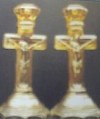Carnival Glass 101 | home Quick Reference to Carnival Glass Patterns
Introduction · How Carnival Was Made · Glass Process · Early Makers · Finding Carnival · Colors · Carnival Glass Edges · Buying Carnival · Carnival Terms · Glass Terms · Reference Books · What is This? · FAQ · Sharing Carnival · Links · Closing
Glass Terms
YESTERYEAR
Excerpts from an article written in Aug. 1952, extracted from VOL.4-NO. 1 (March 1988) issue of the San Diego County Carnival Glass Collectors Newsletter containing definitions prepared by the Nat’l. Better Business Bureau in cooperation w/the American Glassware Assoc.:
Perhaps these definitions (as related to Carnival Glass) will expand your basic knowledge, or refresh your memory.
CUT GLASS : The term “Cut Glass” means that the product has been cut by hand or machine on metal or abrasive wheels or disks into various decorative patterns, but on ly such glass as is cut by hand may be properly described as “Hand-cut-Glass”.
PRESSED GLASS : Pressed glassware is made by pressing molten glass in a mold to the shape and design desired.
a. Hand Pressed Glass is completely fabricated by hand operations
b. Machine Pressed Glass is produced by automatic methods and equipment. Both types and occasionally blown pieces are finished by direct application of flames to produce a smooth and brilliant surface or to alter the shape. This is referred to as “fire polishing”, sometimes called “glazing”.
BLOWN GLASS:
a. Off-hand Blown Glass is produced by expert mouth blowing without the aid of molds. All finishing and polishing are done by craftsmen highly trained through long experience.
b. Hand Blown Glass is always mouth-blown frequently into molds and completely fabricated by hand. Expert workmanship is required.
c. Machine Blown Glass is fed into molds by means of an automatic feeding device and shaped by compressed air.
ETCHED GLASS: Etched glass is produced by a series of operations with strong acids which “eat” the designs into the glass. Some etched designs are imitated by “Sand Blasting” or enamel paint decoration.
EMBOSSED GLASS: Embossing is the opposite of etching, if the design is made in relief by etching out the rest of the glass surface.
GOLD or PLATINUM: May be applied to glassware by brushing, stamping or otherwise applying a solution of gold or platinum, firing it into the glass. Gold stamping means the applying of a gold decoration to glassware by means of a stamp.
FROSTED EFFECT: Produced by exposing all or part of the glass surface to action of acids. Frosting materials are also used to produce a frosted effect by applying adhesives to all or part of the glass surface to which powdered glass grains stick, in which case it is later “fired on” for permanency. Sometimes a frosted effect is produced by sand blasting or by the application of a mat-finish coating either by brush or spray.
COLOR GLASS : Color is produced by the use of various mineral salts – not by a dyeing process. Simulated color is sometimes produced by spraying with ceramic paint fired on for permanency.
CRYSTAL : A term used to indicate colorless glass or glassware as distinguished from tinted, colored or opal glass. When used in connection with art and table glassware, the term “crystal” signifies a transparent lead or lime glass as nearly colorless as can be obtained.
OPAL GLASS : An opaque or translucent glass (the latter often called “Milk Glass”) produced by adding special materials such as fluorspar or other fluorine derivatives to the batch. Many modern shapes are manufactured from this glass and it is used to reproduce traditional pieces. The finish can be glossy or satin.
STRAW MARK : When a gather of molten glass was to be dropped into the mould, just the right amount had to be “cut off” with a pair of shears. The man who did that cutting had to have a keen eye, steady hand, and a LOT of experience in just where to cut that “blob”. As the glass went into the mould, the plunger went into the center to force the molten glass into the shape and pattern being made. If there was just a little too much glass, there might be a slight line where it was pinched when cut by the shears. If there was too little glass, it might not show up at all, or the line might be very faint. Then there were times when that cut was made at precisely the right time and place – and all the glass was perfectly fitted into the mould with no discernible lines from the “shears”. So, when you examine a piece of Carnival Glass which has “flaws” – not chips, cracks, flakes, etc., but a few varying sized bubbles, lines, a twist or turn, it is in MINT CONDITION because that’s the way it came from the glass factory, and it was made by MEN – not machines. STRAW has nothing to do with a SHEAR mark. Chances are that if you insist on having Carnival Glass in your collection WITHOUT “straw marks”, you may have a small collection!
Updated: 2/04—D/D/Fry

God Bless You and Your Day!
back to Carnival Glass 101
Should you care to contact the Frys, their email address is:
Search Carnival Glass 101
Our other sites you may enjoy:
Everything you EVER wanted to know about Indiana Glass
Great Reference for Newer Carnival Glass.
Complete Glassware Catalogs Available to Download
Questions? Comments? Suggestions? Broken Links? Corrections?
Your Friendly Webmaster is here to help!
